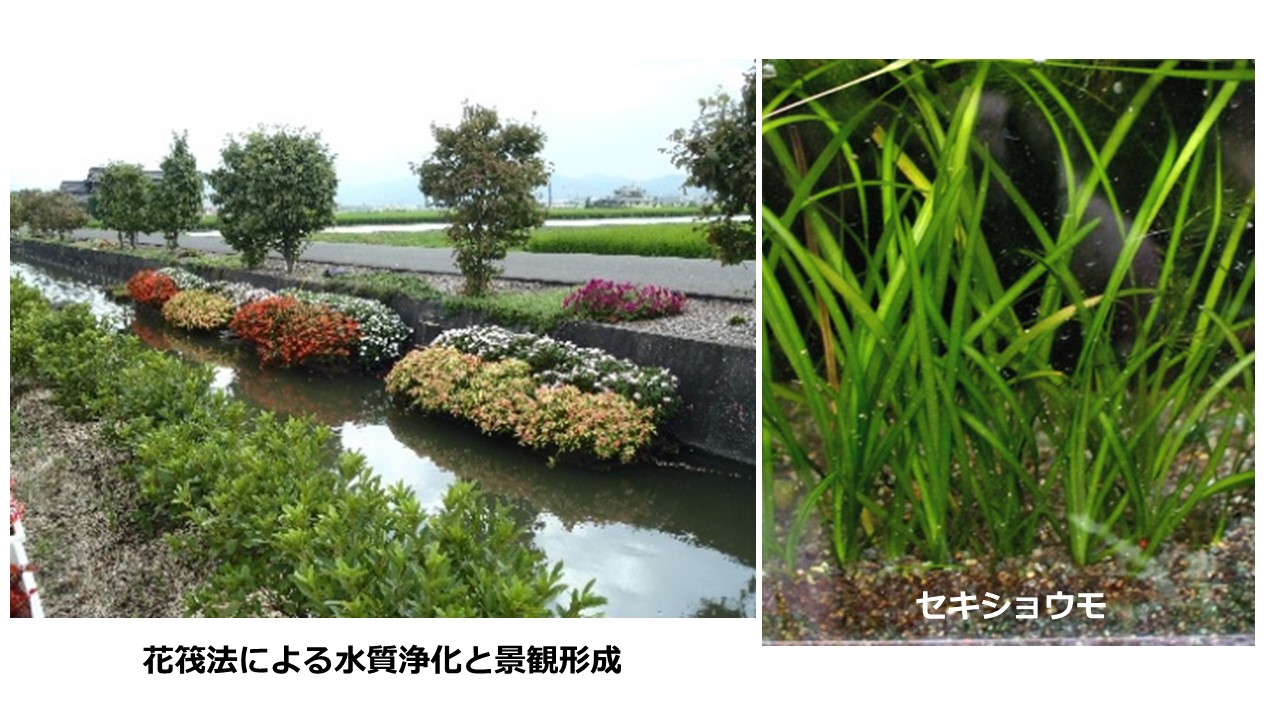Plant Production Science
Development and systematization of production technology for crop cultivation based on improvement of productivity and environment conservation
 |
|
|---|
Weeds not only affect the production of crops, but also have multifaceted functions in nature, such as supporting the base of ecosystems and providing healing to human society by creating green spaces. Therefore, while understanding the physiology and ecology of weeds and other familiar plants to properly manage vegetation, we are also working to solve environmental problems by applying their functions.
Establishment of an appropriate management method for weed overgrowth
The overgrowth of aquatic weeds in rivers and agricultural drainage canals in the southern part of Okayama City is becoming apparent, and there are concerns that this may lead to inland flooding during heavy rains. So we are working to build a control system of aquatic weeds. At the same time,we are examining methods for the conservation of valuable native species that are being destroyed by competition.
Improvement of Water Quality of Agricultural Drainage
The Kojima Lake basin in southern Okayama Prefecture is the largest agricultural area in this Prefecture, but water pollution in the basin has been a long-standing problem as a result of urbanization. To address this problem, we are developing an environmentally friendly water purification method using plants, in order to provide safe and secure agricultural water and to reduce eutrophication of Lake Kojima caused by agricultural drainage.
Ecosystem conservation through weed vegetation
Weed communities provide habitat for a wide variety of organisms and are the foundation of various ecosystems. We aim to enhance the ecosystem services provided by nature by conserving and restoring a variety of declining vegetation from terrestrial to aquatic areas.
 |
|
|---|
Publications
【Group of Dr. NAKASHIMA】
- Nguyen Thi Thanh H., Kobata T. and Saitoh K.: Simplified quantitative description of root distribution across soil depth in rice (Oryza sativa L.) under different soil moisture conditions, . Jpn. Soc. Agric. Technol. Manage., 28, 1-8 (2021)
- Nguyen Quang C., Nguyen Thi Thanh H. and Saitoh K. : Effect of System of Rice Intensification (SRI) on growth and yield performance in Nam Dong district, Thua Thien Hue province, Vietnam, Sci. Rep. Fac. Agr. Okayama Univ., 109, 13-20 (2020)
- Wakai N., Maeda M., Ono T., Hanafusa T., Yamashita J. and Saitoh K. : Radiocesium concentration in stems, leaves, and panicles of rice grown in a sandy soil replacement paddy field treated with different rates of cattle manure compost in Kawamata, Fukushima, Journal of Environmental Science for Sustainable Society 9, 1-10 (2019)
- Sugimoto M., Ashida T., Saitoh K. : Optimum harvesting time of the black-seeded soybean “Tambaguro” for Edamame (green soybean) “Murasakizukin 2” by appearance of pods,Jpn. J. Crop Sci.,87,132-139 (2018)
- Sugimoto M., Ashida T., Okai H., Saitoh K. : Cultivation of the black-seeded soybean “Tambaguro” for Edamame (green soybean) “Murasakizukin 2” in Kyoto Prefecture –Effects of sowing time, planting density and topdressing at the molding time–,Jpn. J. Crop Sci.,87,250-258 (2018)
- Tran T. Q., Maeda M., Oshita K., Takaoka M. and Saito K. : Phosphorus and potassium availability from cattle manure ash in relation to their extractability and grass tetany hazard, Soil Sci. Plant Nutr. 64, 415-422 (2018)
- Nakashima Y., Fujii S., Oki Y., Nakata K.:Examination of the physical control for the invasive weed Hydrocotyle ranunculoides and its role as habitat for aquatic animals, Journal of the Japanese Society of Irrigation, Drainage and Rural Engineering,88,899-902 (2020)
- Nakashima Y., Oki Y., Adachi T., Nagai A., Chikamori H.:Occurrence dynamics of the submerged weed community caused by natural disturbance in class B river Maekawa of South Okayama, Transactions of the Japanese Society of Irrigation, Drainage and Rural Engineering,88,29-37 (2020)
- Nakashima Y., Oki Y.:Differences in flood tolerance of invasive alien species, Iris pseudacorus L. under different cutting treatments, J. Weed Sci. Tech. 62,223-226 (2017)
- Nakashima Y., Oki Y.:Vegetative propagation characteristics of an alien species, Hydrocotyle ranunculoides, J. Jpn. Soc. Reveget. Tech., 42,543-549 (2016)
- Nakashima Y., Oki Y.:A study of harvesting methods for the proper management of narrowleaf cattail (Typha australis Schumach. et Thonn.) and common reed (Phragmites australis (Cav.) Trin. ex Steud.) in urban biotopes,J. Jpn. Soc. Reveget. Tech., 42,236-239 (2016)
【Group of Dr. TANAKA】
- Tanaka, Y., Watanabe, T., Katsura, K., Tsujimoto, Y., Takai, T., Saito, K. et al.: Deep Learning Enables Instant and Versatile Estimation of Rice Yield Using Ground-Based RGB Images. Plant Phenomics. 5, 0073. (2023)
- Nakajima K., Tanaka, Y., Katsura, K., Yamaguchi, T., Watanabe, T., Shiraiwa T.: Biomass estimation of World rice (Oryza sativa L.) core collection based on the convolutional neural network and digital images of canopy. Plant Prod. Sci. 26, 187-196. (2023)
- Taniyoshi, K., Tanaka, Y., Adachi, S., Shiraiwa, T.: Anisohydric characteristics of a rice genotype ‘ARC 11094’ contribute to increased photosynthetic carbon fixation in response to high light. Physiologica Plantarum. 174, e13825. (2022)
- Kondo, R., Tanaka, Y., Shiraiwa, T. Predicting rice (Oryza sativa L.) canopy temperature difference and estimating its environmental response in two rice cultivars, ‘Koshihikari’ and ‘Takanari’, based on a neural network. Plant Prod. Sci. 25, 394-406. (2022)
- Shamim, MJ., Kaga, A., Tanaka, Y., Yamatani, H., Shiraiwa, T.: Analysis of Physiological Variations and Genetic Architecture for Photosynthetic Capacity of Japanese Soybean Germplasm. Front. in Plant Sci. 13, 910527. (2022)
- Tanaka, Y., Taniyoshi, K., Imamura, A., Mukai, R., Sukemura, S., Sakoda, K., Adachi, S.: MIC-100, a new system for high-throughput phenotyping of instantaneous leaf photosynthetic rate in the field. Functional Plant Biology. 49, 496-504. (2022)
- Sakoda, K., Adachi, S., Yamori, W., Tanaka, Y.: Towards improved dynamic photosynthesis in C3 crops by utilizing natural genetic variation. J. Exp. Bot. 73, 3109-3121. (2022)





